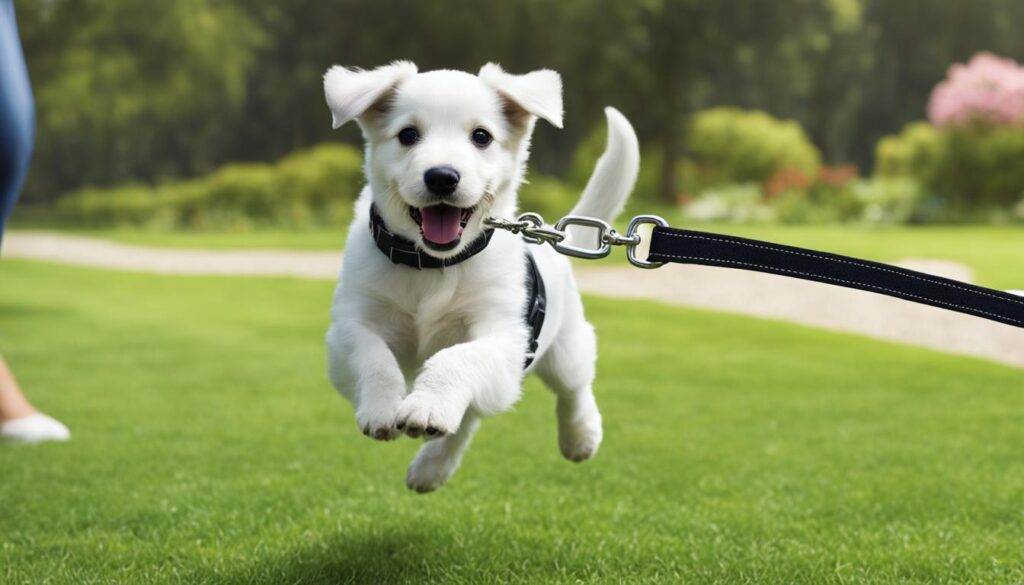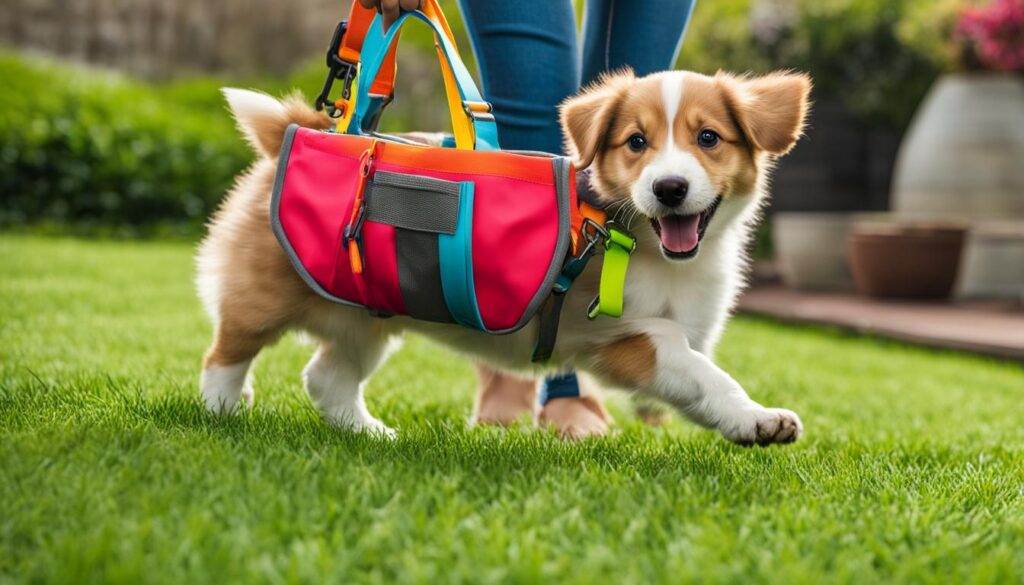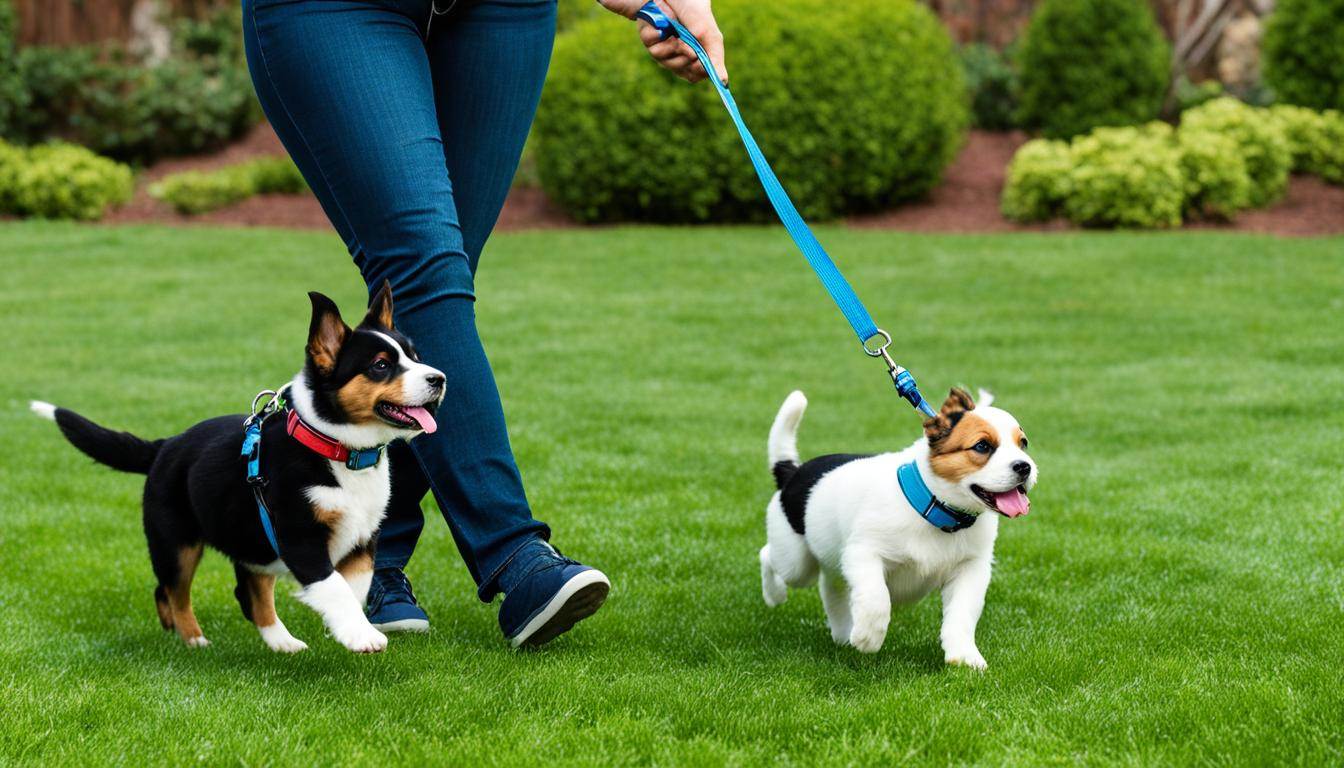When it comes to training your puppy, choosing the right leash is crucial for a smooth and effective learning experience. There are various types of leashes available, each with its own advantages and considerations. In this article, I will explore the different types of leashes for puppy training, their features, and which ones are best suited for specific training needs.
Key Takeaways:
- There are different types of leashes available for puppy training, each with its own advantages and considerations.
- Long leashes provide versatility and practicality, with adjustable lengths and hands-free walking options.
- Retractable leashes offer controlled freedom for puppies in certain situations, but should always be used with a harness.
- Leather leashes are known for their durability and style, often available in matching collar and harness options.
- Double-ended leashes provide dual control during training sessions, offering flexibility and balance.
The Benefits of Long Leashes for Puppy Training
Long leashes are a popular choice for puppy training due to their versatility and practicality. These leashes are longer than regular dog leashes, typically ranging from 1.5m and up, and offer several benefits.
One of the main advantages of long leashes is their adjustable length. They feature rings and clips that allow for easy customization, enabling you to find the perfect length for your training needs. Whether you want to give your puppy more freedom to explore or keep them closer for better control, you can easily adjust the leash accordingly.
Long leashes provide two points of contact on the dog, which ensures good balance and control during training sessions. With a longer leash, you have more flexibility in guiding your puppy’s movements and redirecting their attention as needed.
Hands-free walking is another feature commonly found in long leashes. Some models come with waist attachments, allowing you to keep your hands free while still maintaining control over your puppy. This feature is particularly beneficial for activities such as jogging, hiking, or simply having your hands available for other tasks.
Long leashes can also be used for settle training. By wrapping the leash around a sturdy chair leg or another secure object, you can give your puppy a limited range of movement while training them to relax and settle in a specific area. This technique helps promote calm behavior and can be especially useful for teaching your puppy to stay calm when visitors are present or during mealtimes.
When it comes to comfort and security, long leashes are designed with your puppy’s needs in mind. They are made from durable materials that are comfortable to hold and ensure a secure grip while training. Long leashes also come in a variety of widths, making them suitable for puppies of different sizes and breeds.
Advantages of Long Leashes for Puppy Training:
- Adjustable length for customized training
- Two points of contact for balance and control
- Hands-free walking for convenience
- Settle training to promote calm behavior
- Comfortable and secure grip
Overall, long leashes are a versatile and effective tool for puppy training. They provide the necessary freedom and control required for successful training sessions while keeping your puppy safe and comfortable. Consider investing in a long leash when starting your puppy’s training journey.
| Advantages of Long Leashes for Puppy Training | Keywords |
|---|---|
| Adjustable Length | types of leash for puppy training, adjustable length leashes |
| Balance and Control | types of leash for puppy training, hands-free walking leashes, settle training leashes |
| Hands-Free Walking | types of leash for puppy training, hands-free walking leashes |
| Settle Training | types of leash for puppy training, settle training leashes |
| Comfortable and Secure | types of leash for puppy training, comfortable and secure leashes |
Retractable Leashes for Controlled Freedom
When it comes to puppy training, one option that provides controlled freedom is the retractable leash. While it’s important to use them correctly to avoid teaching your puppy to pull, retractable leashes can be beneficial in specific circumstances.
Retractable leashes are designed to extend up to 5 meters, allowing your puppy to explore while still remaining under control. They are commonly used in parks or areas where dogs must be kept on a leash, providing a balance between freedom and obedience. The quick stop braking system ensures that you can quickly regain control if needed, preventing runaway situations.
For the safety of your puppy, always use a retractable leash with a harness instead of a collar. This helps protect their neck from any sudden jerks or pulls. Additionally, some retractable leashes offer features like reflective neon, enhancing visibility during nighttime walks. They may also have storage options for poo bags and treats, making it convenient to carry essentials during your training sessions.
To sum up, retractable leashes offer controlled freedom, allowing your puppy to explore and learn while maintaining control. Make sure to use them with a harness, adhere to safety precautions, and only use them in appropriate circumstances. With proper usage, a retractable leash can be a valuable tool in your puppy training toolkit.

Leather Leashes for Durability and Style
When it comes to puppy training, leather leashes are a top choice for dog owners seeking a combination of durability and style. These leashes are available in various widths and lengths, allowing you to find the perfect fit for your puppy’s training needs. The adjustable length feature adds another level of convenience, ensuring the leash can be customized to accommodate different training scenarios.
One of the key advantages of leather leashes is their comfortable and secure grip. The natural oils in the leather make it soft to hold, preventing any discomfort or irritation during training sessions. This feature is especially beneficial for puppy owners who have extended training sessions or who experience hand fatigue.
Additionally, leather leashes are known for their stylish appearance. They come in a wide range of colors, allowing you to choose a leash that complements your puppy’s personality and your personal style. Many leather leash options also have matching collars and harnesses available, offering a cohesive and fashionable look for your puppy.
Whether you have a small puppy or a larger dog, leather leashes provide a secure and reliable training tool. They are designed to withstand daily wear and tear, making them a long-lasting investment. With their durability, comfort, and style, leather leashes are a top choice for puppy training.
Next, let’s explore the advantages of double-ended leashes for dual control during puppy training.
Double-Ended Leashes for Dual Control
When it comes to puppy training, having dual control over your furry friend is essential. That’s where double-ended leashes come in. These innovative leashes have clips at both ends, allowing you to attach them to different points on your puppy’s harness. By doing so, you can achieve better control and balance during training sessions.
One of the key advantages of double-ended leashes is their adjustable length. You can easily customize the leash to suit your specific training needs. Whether you need a shorter leash for heel training or a longer leash for recall exercises, a double-ended leash has got you covered.
Comfort and security are also top priorities when it comes to double-ended leashes. Many of them are made with rubber-based materials that provide a non-slip grip, even when wet. This ensures that you have a firm hold on the leash during training sessions, promoting safety and control.
Furthermore, some double-ended leashes are custom-made to order. This means that you can have a leash specifically tailored to your puppy’s unique needs. From size to color, you can personalize every aspect of the leash for maximum comfort and effectiveness.
Double-ended leashes are a popular choice for training sessions that require extra control and flexibility. Whether you’re working on loose leash walking, obedience training, or behavioral correction, these leashes provide the necessary tools to assist you in achieving your training goals.
Benefits of Double-Ended Leashes:
- Allows for dual control during training
- Adjustable length for customized training sessions
- Comfortable and secure grip, even when wet
- Custom-made options for a perfect fit

| Pros | Cons |
|---|---|
| Provides dual control during training | May take time for puppies to get used to two points of contact |
| Adjustable length for customized training sessions | Requires proper coordination to manage both leash ends |
| Comfortable and secure grip, even when wet | May not be suitable for all types of training |
| Custom-made options for a perfect fit | May be more expensive compared to traditional leashes |
As you can see, double-ended leashes offer a range of benefits that make them an excellent choice for puppy training. If you’re looking for a leash that provides dual control, adjustable length, comfort, and customization, a double-ended leash is the way to go.
Six-in-One Leashes for Versatility
When it comes to puppy training, having a leash that can adapt to different scenarios is essential. That’s where six-in-one leashes come in. These versatile leashes, as the name suggests, can be used in six different ways, making them a valuable tool for puppy owners.
Six-in-one leashes offer a range of benefits that make them a popular choice among trainers and pet parents alike. They often feature reflective strips, ensuring visibility during evening walks, and a padded handle for comfort during training sessions. Additionally, these leashes are adjustable in length, allowing you to customize the fit for your puppy.
One of the advantages of a six-in-one leash is its versatility. It can be used as a standard leash for basic walks, a hands-free leash for joggers or those who prefer a hands-on training approach, and even as a tether or training line for specific exercises. This adaptability is particularly valuable for puppy owners who want a multi-functional training tool that can cater to different training needs.
Another benefit of six-in-one leashes is that they often come with a lifetime warranty. This provides pet parents with peace of mind, knowing that their investment is protected. With a durable leash that can withstand daily use, you can focus on training and enjoying time with your puppy.

| Benefits of Six-in-One Leashes |
|---|
| 1. Versatility – Can be used in six different ways |
| 2. Adjustable length for a customized fit |
| 3. Reflective strips for visibility during night walks |
| 4. Padded handle for comfort during training sessions |
| 5. Lifetime warranty for added peace of mind |
In summary, six-in-one leashes offer unparalleled versatility for puppy training. With their multiple functions, adjustable length, and added features like reflective strips and padded handles, these leashes provide convenience, comfort, and safety for both you and your puppy. Invest in a six-in-one leash to make training sessions more efficient and enjoyable.
Selecting the Right Leash for Lead Training
When it comes to lead training, choosing the right leash is crucial for the success of your training sessions. The leash you select should provide the perfect balance of control, comfort, and adjustability. For lead training, a 2-meter training leash attached to a harness is highly recommended. This length allows your puppy enough freedom to learn and explore while keeping them under your control.
Considerations for lead training leashes include:
- Comfortable to hold: Look for leashes with padded handles or soft materials that provide a comfortable grip during training sessions.
- Secure attachment: Ensure that the leash securely attaches to your puppy’s harness, minimizing the risk of accidental detachment.
- Adjustable length: A leash with an adjustable length allows you to customize the amount of freedom your puppy has during training. This feature is especially useful when progressing from close walking to loose leash walking.
By selecting a leash that meets these considerations, you can guide your puppy effectively and make the lead training process smoother and more successful.

| Type of Leash | Features |
|---|---|
| 2-Meter Training Leash |
|
Avoiding the Use of Shock Collars
When it comes to puppy training, the use of shock collars is not recommended. These devices are not ethical and do not provide a humane way to teach loose lead walking. Instead, it is important to prioritize your puppy’s well-being and choose training methods and tools that promote positive reinforcement and a positive training experience.
One alternative to shock collars is to use normal collars that allow your puppy to breathe and learn comfortably. These collars provide a secure and safe way to guide your puppy during training sessions without causing unnecessary discomfort or harm.
Positive reinforcement training methods are key to shaping your puppy’s behavior effectively. By rewarding desired behaviors with treats or praise, you create a positive association and motivate your puppy to continue behaving appropriately. This approach focuses on building a strong bond with your puppy and helps them develop desired behaviors willingly and happily.
Choosing the right leash and harness for puppy training is another important aspect to consider. There are various types of leashes available, each with its own advantages and considerations. Select a leash that is comfortable to hold, secure, and suitable for your training goals. By combining positive reinforcement training methods with the right leash and harness, you can create a positive and effective training experience for your puppy.
Remember, promoting humane alternatives to shock collars is crucial to ensure the well-being and happiness of your puppy. Opt for ethical training methods that prioritize your puppy’s comfort and create a positive and enjoyable training environment.

| Benefits of Avoiding Shock Collars |
|---|
| 1. Ethical Training: Using humane alternatives promotes ethical training methods that prioritize your puppy’s well-being. |
| 2. Positive Reinforcement: Positive reinforcement training creates a positive association and motivates your puppy to obey commands and follow desired behaviors. |
| 3. Comfort and Safety: Normal collars allow your puppy to breathe and learn comfortably, preventing unnecessary discomfort or harm. |
| 4. Strong Bond: By focusing on positive reinforcement and avoiding shock collars, you can build a strong bond with your puppy based on trust and positive interactions. |
| 5. Effective Training: The right leash and harness, combined with positive reinforcement training methods, create an effective and compassionate training experience for your puppy. |
Starting Leash Training Early
Leash training is an important aspect of teaching your puppy obedience and ensuring their safety during walks. By starting leash training early, you can establish good habits and a strong foundation for future training. Here’s how to get started:
- Introduce the concept: Begin by getting your puppy used to the idea of being on a leash. Let them sniff and explore the collar or harness before attaching the leash.
- Positive reinforcement: Use treats to associate the leash with positive experiences. Reward your puppy with treats and praise when they follow you on the leash.
- Short and frequent walks: Start with short walks in a familiar and quiet area. Gradually increase the duration and distance as your puppy becomes more comfortable.
- Proper leash position: Teach your puppy to walk by your side on a loose leash, rather than pulling or lagging behind. Use gentle guidance and reward them when they maintain the desired position.
The importance of early leash training cannot be overstated. It helps your puppy develop good leash manners, prevents pulling on the leash, and promotes a positive walking experience for both of you. Remember to be patient and consistent throughout the training process.
Leash training is an ongoing process that requires time and effort, but with dedication and positive reinforcement, you can teach your puppy to walk politely on a leash.
“The early stages of leash training are crucial for establishing a strong bond with your puppy and teaching them the skills they need to be a well-behaved companion.”

| Type of Leash | Features | Benefits |
|---|---|---|
| Standard Leash | Durable and easy to use | Simple and affordable option for everyday walks |
| Retractable Leash | Adjustable length, allows freedom of movement | Ideal for controlled exploration in open areas |
| Training Leash | Adjustable length, multiple attachment points | Enables dual control for training purposes |
| Nylon Leash | Lightweight and durable | Great for puppies of all sizes |
By understanding the different types of leashes available and starting leash training early, you can set your puppy up for success. Remember to use treats and positive reinforcement to make the training experience enjoyable for your furry friend. With consistent training and patience, your puppy will become a well-trained and obedient companion on walks.
Personalized Training Schedules and Support
To ensure the success of your puppy’s leash training, it is vital to utilize personalized training schedules and professional support. With personalized training schedules, you can tailor your puppy’s training sessions to their unique needs, ensuring efficient progress and effective learning.
One excellent resource for personalized training schedules and expert guidance is the ZigZag training app. Designed specifically for puppy training, ZigZag offers customized training plans based on your puppy’s age, breed, and specific training goals. The app provides step-by-step instructions for each training session, ensuring that you cover all the essential skills and behaviors your puppy needs to learn.
What sets ZigZag apart is its 24/7 puppy expert coaching. At any time, day or night, you can consult with experienced trainers who can answer your questions, provide advice, and offer solutions to any training issues you may encounter. This round-the-clock support ensures that you receive timely assistance whenever you need it, leading to a more successful training experience.
In addition to personalized training schedules and expert coaching, the ZigZag training app also includes a wide range of daily dog exercises. These exercises are designed to keep your puppy engaged and active, promoting mental and physical stimulation. By incorporating these exercises into your training routine, you can provide a well-rounded approach to your puppy’s development.
Using the ZigZag app for personalized training schedules, expert coaching, and daily dog exercises is a game-changer for your puppy’s training journey. With this comprehensive tool, you can track your puppy’s progress, receive expert advice, and ensure consistent training success.
Make the most of your puppy’s training by harnessing the power of personalized schedules, 24/7 expert coaching, and engaging exercises with the ZigZag training app. Start your puppy’s training off on the right paw and set them up for a lifetime of obedience and good behavior.
Summary Table: Features of the ZigZag Training App
| Feature | Description |
|---|---|
| Personalized Training Schedules | Create customized training plans based on your puppy’s age, breed, and training goals. |
| 24/7 Expert Coaching | Access experienced trainers who can provide guidance, answer questions, and offer support. |
| Daily Dog Exercises | Engage your puppy with a variety of exercises that promote mental and physical stimulation. |
| Progress Tracking | Monitor your puppy’s progress and track their achievements throughout the training process. |
| Training Reminders | Receive timely reminders and notifications to ensure consistency in your training sessions. |
| Training Resources | Access a wealth of training resources, including articles, videos, and tips for successful training. |
Conclusion
Choosing the right leash for puppy training is a crucial step in ensuring a successful and enjoyable training journey. With a wide range of leash options available, including long leashes, retractable leashes, leather leashes, double-ended leashes, and six-in-one leashes, it’s important to consider the specific needs of your puppy.
When selecting a leash, prioritize your puppy’s comfort and safety. Consider the features and benefits of each leash type, such as adjustability, durability, and style. By choosing the best leash for puppy training, you can establish a strong bond with your puppy and set them up for a lifetime of obedience and good behavior.
Remember, the right leash is just one part of effective puppy training. Combine it with proper training techniques, positive reinforcement, and patience to achieve the best results. Investing time and effort into training your puppy with the right leash will lead to a well-trained and well-behaved companion.
FAQ
What types of leashes are recommended for puppy training?
The recommended types of leashes for puppy training include long leashes, retractable leashes, leather leashes, double-ended leashes, and six-in-one leashes.
What are the benefits of using long leashes for puppy training?
Long leashes offer versatility, adjustable length, multiple points of contact, and hands-free options for settle training.
Are retractable leashes suitable for puppy training?
Retractable leashes can be useful for controlled freedom during training, but proper usage and safety precautions should be followed.
Are leather leashes a good choice for puppy training?
Leather leashes are durable, stylish, comfortable to hold, and come in adjustable lengths. They also often have matching collars and harnesses available.
How do double-ended leashes provide dual control during puppy training?
Double-ended leashes have clips at both ends, allowing you to attach them to different points on your puppy’s harness for better control and balance.
What are the advantages of using six-in-one leashes for puppy training?
Six-in-one leashes offer versatility, adjustable length, padded handles, and reflective strips for various training scenarios.
What type of leash is recommended for lead training?
A 2-meter training leash attached to a harness is recommended for lead training, providing enough freedom while still maintaining control.
Should shock collars be used for puppy training?
No, shock collars are not recommended for puppy training due to ethical concerns. Positive reinforcement methods combined with appropriate leashes and harnesses are preferred.
When should leash training start for puppies?
Leash training should begin as early as possible after bringing your puppy home to establish good habits and behavior.
Are there training tools and support available for puppy training?
Yes, personalized training schedules and support are available through training apps like ZigZag, which provide guidance, expert coaching, and engagement exercises for puppies.
What should be considered when choosing a leash for puppy training?
When choosing a leash for puppy training, consider the puppy’s comfort, safety, and specific training goals to make the best selection.

